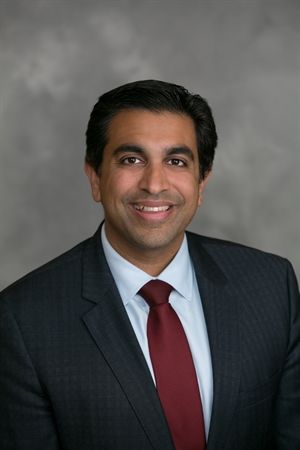Article
Abicipar Could Be Effective Treatment for Neovascular AMD
Author(s):
Data from 2 phase 3 trials, which included more than 1800 patients, examining the efficacy and safety profile of abicipar for the treatment of neovascular age-related macular degeneration were presented at AAO 2019.

Rahul Khurana, MD
Results of multiple phase 3 studies presented at the American Academy of Ophthalmology (AAO) 2019 Annual Meeting in San Francisco are highlighting abicipar’s potential as a treatment for patients suffering from neovascular age-related macular degeneration.
The CEDAR and SEQUOIA studies, which were randomized, double-masked, parallel-group clinical trials with identical protocols, showcased the efficacy and safety of abicipar in more than 1800 patients.
“This data shows you that with a q12 regimen, you can be confident that these patients will do well for 2 years,” said Rahul Khurana, MD, a vitreoretinal surgeon with of Northern California Retina Vitreous Associates Medical Group, who presented results during a late breakers session on Friday.
The 1888 patients enrolled in CEDAR and SEQUOIA were randomized to receive either abicipar(630) every 8 weeks, abicipar(628) every 12 weeks, or ranibizumab(630) every 4 weeks. In the abicipar q8 group, 522 completed until week 52 and 446 completed until week 104. In the abicipar q12 group, 515 completed until week 52 and 444 completed through week 104. In the ranibizumab group, 583 completed until week 52 and 521 completed through week 104.
The primary endpoint of the study was the proportion of patients with stable vision, which was defined as a loss of less than 15 ETDRS letters, at week 52. Secondary endpoints of the study included mean change form baseline in ETDRS BCVA, mean change from baseline in CRT, and proportion of patients with a 15-letter or greater gain at week 52.
At week 52 of the study, the percentage of patients who achieved stable vision in the abicipar q8 group was 96%, 94% in the abicipar q12 group, and 97% in the ranibizumab group. At week 104, the percentage of patients with stable vision was 93% with abicipar q8, 90% with abicipar q12, and 94% with ranibizumab.
The mean gain from baseline in BCVA at week 52 with abicipar q8 was 8.9, 7.4 with abicipar q12, and 9.5 with ranibizumab. At week 104, the mean change was 7.8 with abicipar q8, 6.1 with abicipar q12, and 8.5 with ranibizumab. Investigators pointed out this represented a mean drop of 1.1 in the abicipar q8 group, 1.3 in the abicipar q12 group, and 1 in the ranibizumab group.
Investigators noted an increase in the rate of treatment-emergent adverse events in the abicipar q12 group. Khurana suggested this was caused by an increase in intraocular inflammation that was seen in the abicipar q12 group through week 52.
Khurana went on to add that incidence of intraocular inflammation decreased in the abicipar q12 group following week 52 and there were no new cases of retinal vasculitis and endophthalmitis from abicipar groups in year 2 of the study. The pooled monthly rate of intraocular inflammation in the abicipar groups was 2.95% in months 0 to 3 and continually decreased until it reached 0.21% in months 12 to 24.
This study, “Abicipar for Neovascular AMD: Two-Year Results From CEDAR and SEQUOIA Phase 3 Clinical Trials,” was presented by Rahul Khurana, MD, at AAO 2019.




